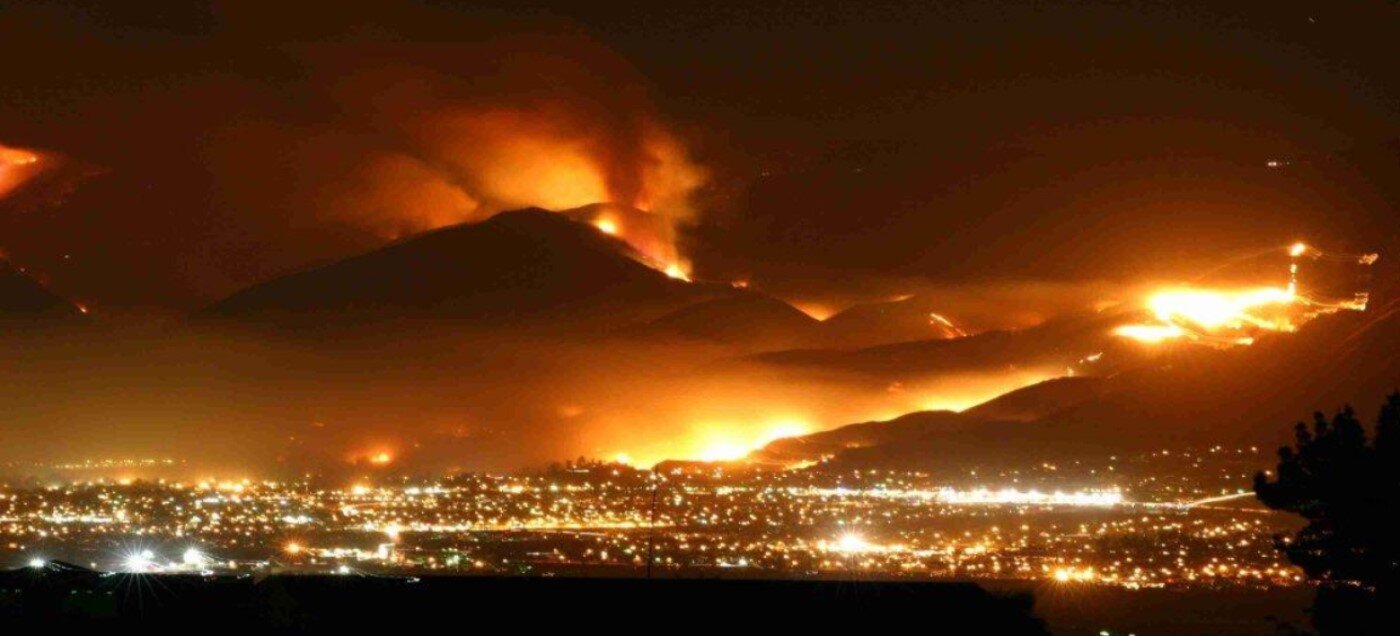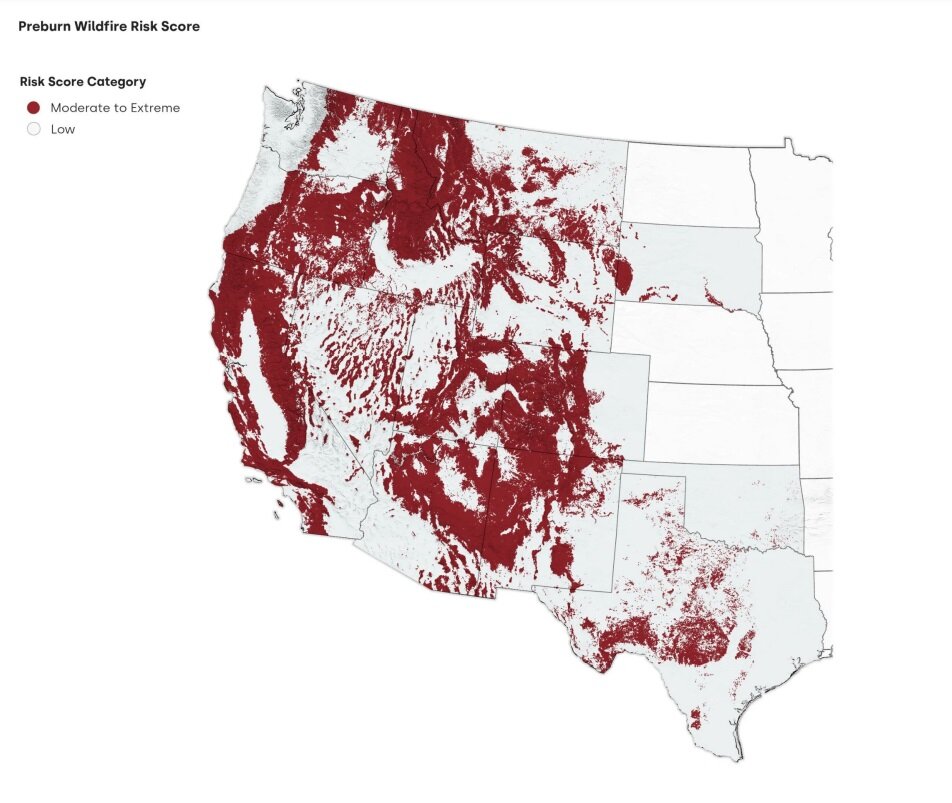Residential Real Estate News

Over 2.6 Million Western U.S. Homes at Risk of Wildfire Damage in 2024
Residential News » Los Angeles Edition | By Michael Gerrity | August 15, 2024 7:06 AM ET
Based on the recently released 2024 CoreLogic Wildfire Risk Report, more than 2.6 million homes across 14 states are at moderate to very high risk of wildfire damage during the 2024 wildfire season, with a total reconstruction cost of $1.3 trillion.
The western United States has the greatest wildfire risk with three states comprising 70% of the risk. The following states having the highest number of homes at moderate or greater risk of wildfire exposure:
- California: 1,258,748 homes at risk
- Colorado: 321,294 homes at risk
- Texas: 244,617 homes at risk
- Oregon: 129,567 homes at risk
- Arizona: 124,603 homes at risk
These states face an elevated level of risk because of the high number of homes in undeveloped areas, or with exposure to Wildland-Urban Interface, where homes are near wildlife such as trees, vegetation and other flammable materials. The Los Angeles metropolitan area leads the nation with the highest number of homes at risk, with more than 245,000 homes with moderate or greater risk of wildfire, representing a total reconstruction value of $186.6 billion although not all homes that experience a loss in a wildfire scenario will be a total loss.
"In recent years, we've seen wildfires occur in unexpected places, reinforcing the need to understand the risk landscape and take mitigation action. Both insurers and consumers have a role to play to ensure adequate protection," said Jon Schneyer, CoreLogic's director of catastrophe response. "These numbers may seem overwhelming, but research shows that mitigation efforts make a real difference in potential losses from wildfires. The good news is there are actions people can take to lessen the risk."
Effective mitigation strategies
There have been multiple devastating wildfires in recent years that have highlighted the need for individuals and communities to take mitigation action. For example, the Camp Fire of 2018 decimated more than 90% of the town of Paradise, California. A recent collaborative study with the Town of Paradise, Milliman, Inc, and CoreLogic found combining individual home- and community-level mitigation strategies led to a 75% reduction in expected loss per property in high-risk areas like Paradise, which can also lead to lower insurance premiums.
Effective mitigation is a combined effort between communities and individuals. Some mitigation tactics for individuals include:
- Create a five-foot buffer around the home by removing vegetation, trees, overhanging branches, grass/turf, wood fencing, etc. within five feet of the home.
- Do not store anything--including vehicles--within the five-foot buffer zone.
- Prepare the home with a Class A-fire rated roof, metal gutters, and ember resistant vents.
- Maintain the deck and yard within 30 feet of the home by routinely clearing tree debris, replacing combustible furniture and moving firewood and propane tanks.
Community-level mitigation efforts include:
- Leveraging Wildfire Informed Development Patterns- the strategic planning of development patterns informed by wildfire risk.
- Selectively decreasing the number of structures within town boundaries, focusing on rebuilding in areas with lower wildfire risk and being intentional with land use planning.
- Implementation of external buffers- well-maintained areas with low fire spread potential on the border of the town.
Sign Up Free | The WPJ Weekly Newsletter
Relevant real estate news.
Actionable market intelligence.
Right to your inbox every week.
Real Estate Listings Showcase
Related News Stories
Residential Real Estate Headlines
- Las Vegas Area Home Prices Uptick 4.3 Percent Annually in March
- Single-Family Rent Growth in U.S. Trends Upward in 2025
- U.S. Mortgage Rates Tick Down Post Trump Tariffs Commencement
- President Trump's 'Liberation Day' Tariffs Potential Impact on the U.S. Housing and Mortgage Markets
- Baby Boomers Biggest Cohort of U.S. Home Buyers in 2025 as Millennials Decline
- U.S. Monthly Housing Payments Hit Record High in 2025
- U.S. Pending Home Sales Uptick in February
- Global Prime Residential Rent Slowdown Continued in Late 2024
- Ireland Home Price Inflation Hits 8 Year High in Early 2025
- Existing Home Sales in America Uptick in February
- Great Miami Area Residential Sales Decline 15 Percent Annually in February
- Mortgage Rates Uptick in Mid-March, Ending 9-Week Decline in U.S.
- World Property Ventures Builds the Future of Real Estate with New Funding Round
- U.S. Builder Sentiment Declines Amid Economic Uncertainty and Rising Costs
- Black Homeownership Rates in U.S. Enjoy Largest Annual Increase of All Racial Groups
- Wealthy Renters Are Taking Over More of the U.S. Rental Market
- If U.S. Congress Does Not Extend NFIP Soon, Thousands of Daily Home Closings Impacted
- U.S. Mortgage Applications Spike 11 Percent in Early March
- Greater Palm Beach Area Residential Sales Rise in Early 2025
- New Apartments in U.S. Are Leasing at Slowest Pace on Record
- U.S. Mortgage Rates Drop to 4 Month Low in March
- Overall U.S. Mortgage Delinquency Rates Dip in December
- New Tariffs on Canada, Mexico to Impact U.S. Homebuilder Input Costs
- Monaco's Property Market: A Tale of Two Cities
- U.S. Home Purchase Cancellations Surge, 1 in 7 Sales Getting Canceled
- U.S. Pending Home Sales Hit Historic Low in Early 2025
- Greater Miami Area Residential Sales Dip in January
- Governor DeSantis Supports Ending Property Taxes in Florida
- WPV Aims to Become the Berkshire Hathaway of Real Estate Tech
- U.S. Home Sales Slump Continues in January
- Average Americans Spend 38 Percent of Monthly Income on Mortgage Payments
- Switzerland's Safe-Haven Appeal Grows with World's Wealthy Homebuyers
- U.S. Builder Confidence Rapidly Declines in February
- Las Vegas Home Sales Rise 6.7 Percent Annually in January, Condo Sales Dip
- Homebuyer Demand in America Drops to 5-Year Low in Early 2025
- Ownership More Affordable Than Renting in Most U.S. Markets
- The World's First Global Listings Service Launches, Called a GLS
- Home Prices Continue to Rise in 89 Percent of U.S. Metros in Late 2024
- Global Luxury Residential Prices Showed Gradual Improvement in Late 2024
- U.S. Construction Hiring Rate Drops to Lowest Levels in 5 Years






